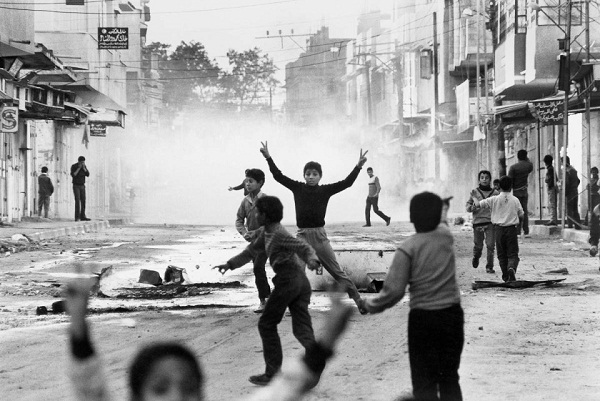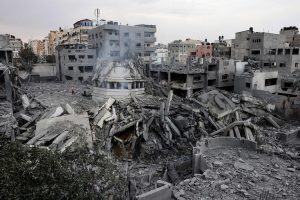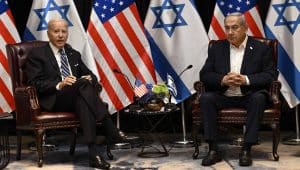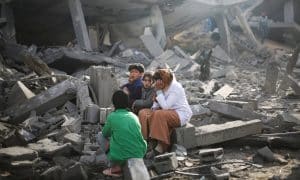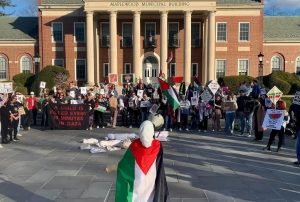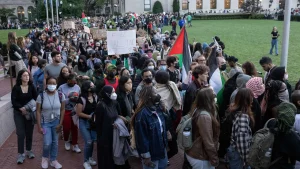On the 33rd anniversary of the First Intifada by Palestinians in 1987, the new Israeli ambassador to the United Kingdom made her first speech in her official capacity. Speaking at an event organized by the Board of Deputies of British Jews, Tzipi Hotovely described the Nakba as “a very strong and very popular Arab lie.”
The Nakba — literally “catastrophe” in Arabic — refers to the massacres and expulsion of the Palestinians from their lands during the artificial creation of the State of Israel. Commemorated each year on May 15, it is a reminder that more than 700,000 Palestinian Arabs — about half of pre-World War II Palestine’s Arab population — were forcibly expelled from their homes or fled the war that was carried out to secure Israeli’s founding. The Nakba saw nearly 600 Palestinian villages sacked by Zionist paramilitary terrorist organizations hell-bent on clearing the land of its rightful occupants — including the infamous Deir Yassin massacre when they murdered women and children in the streets and burned their bodies.
It was the beginning of the war crimes against humanity that are a routine feature of how Israel deals with its “Palestinian problem.” And now in 2020, in a perverse homage to the “fake news” of Israel’s ardent supporter Donald Trump, the ambassador has called the Nakba fake. The real lie, though, is in the false story of why Israel was founded: not to give Jews a protective “homeland,” but to use Israel as a cover for imperialism, which desperately needed a cop in the region to ensure that the Arab states — and their oil wealth — could be controlled by the West. The real fake news is that the racist, colonialist ideology of Zionism has anything to do with the religion of Judaism. Their aims and central tenets are mutually exclusive.
The First Intifada Erupts in 1987
The First Intifada was an uprising, primarily of Palestinian youth, that began in earnest on December 9, 1987. It was directly related to the nearly 40 years of oppression and deprivation the Palestinian people had endured since the Nakba.
The spark that started the fire was the murder of four young Palestinians who were run over by an Israeli soldier at a checkpoint in the Jabalia refugee camp in the Gaza Strip. Of course, Israel characterized this as an “accident”— but Palestinians knew better. The violent murder ignited the fury of a group of Palestinian demonstrators, among them three young people — ages 17, 11, and 10 — who were killed by Israeli soldiers. Demonstrations spread like wildfire and continued until the beginning of the 1990s, by which time 1,559 Palestinians (304 minors) had been killed. Some 400 Israelis, mostly soldiers, also lost their lives, according to the Israeli human rights organization B’tselem.
This mass uprising was led by a new generation of Palestinian youth and especially young women born after the devastation of the Nakba in 1948. Its young leaders were also too young to remember Egypt’s domination of the Gaza Strip, or Jordan’s takeover of the West Bank and East Jerusalem (prior to 1967, when it was captured by the Israelis in another war) — the two territories where a significant portion of the Palestinian people had been concentrated after being forced to flee the Zionist state’s policies of ethnic cleansing that uprooted 1 million Palestinians from their homes.
You might be interested in: A Brief History of the Construction of the State of Israel
This new generation witnessed an explosive increase in Zionist colonization in the Palestinian territories as their living conditions went down the drain. In 1975, there were 2,500 Jewish settlers, but by 1985 that number had grown to 60,000, living in 100 settlements. Today, 33 years since the First Intifada, some 600,000 Israelis live in 140 illegal settlements peppered throughout what are called the Occupied Territories, and more than 100 companies from imperialist countries do business in the region. These settlements have special protective zones behind massive walls, segregated roads that cut through Palestinian lands, and trigger-happy settlers who are keen to fire on Palestinians outside the settlements — often seemingly for racist sport.
Thousands of these young people, unshackled by the conservatism of their elders and who had come of age with a deep hatred of colonization, in 1987 constituted the front line that confronted the Israeli troops, throwing Molotov cocktails and stones from the nearby hills and on the streets.
Thousands from the refugee camps and schools run by the United Nations Relief and Works Agency (UNRWA, the UN refugee agency for Palestine) formed the first street battalions, assisted by children and the elderly. Women stood out, playing an important role at the head of the vanguard, putting their bodies in front of the Israeli tanks and troops — putting the lie to another Western falsehood that depicts Palestinian women submissive, assigned only the role of weeping and suffering. The women’s movement formed relief committees that broke the Israeli curfews to bring food and medicine to the neighborhoods under siege. The women mounted protests against the imprisonment of thousands who were languishing in Israeli prisons. Around 3,000 women were imprisoned during this period.
Reconstitution of the Palestinian Nationalist Movement
The Intifada erupted like a volcano, reconstituting a Palestinian nationalist movement against the Zionist occupation and giving birth to new organizations coordinated by the Unified National Leadership of the Uprising. At first spontaneous and led by grassroots activists, this mass organization soon came under the leadership of the historic organizations of the Palestinian anti-Zionist resistance, Fatah and the Palestinian Liberation Organization (PLO) — despite that its leadership, headed by Yasser Arafat, was in exile in Tunisia. After the crushing blows dealt by the Israeli Army in Beirut and in the Sabra and Shatila massacre, that leadership had been forced to escape Lebanon in 1982.
The new organizations of the masses declared a general strike against Israeli repression and advocated struggle in the streets. Soon, older Palestinians of the middle class joined the fight; the brutal deterioration of the standard of living had ruined them, and they began a civil disobedience movement by refusing to pay taxes and fines and boycotting Israeli goods.
Within this context, the movement developed two strands. One focused on the struggle against the Zionist occupation of the Palestinian territories outside the formal borders of Israel. The other went further, adopting as its strategic objective the destruction of the State of Israel and the return to historic Palestine.
Israel’s response to the First Intifada was especially brutal. Particularly infamous were the videos of Israeli soldiers capturing young teens who had thrown rocks at tanks and breaking their hands and fingers with clubs. They employed “semi-lethal” rubber bullets and indiscriminately fired them at young demonstrators. This repression of the Palestinians exposed and discredited the Zionists internationally, creating some fissures among Israelis themselves. Thousands of soldiers and officers conscientiously objected and refused to serve in the Occupied Territories. These Refuseniks — who had appeared initially during the first Lebanon War that the Israeli government had dubbed Operation Peace for Galilee — chose to face military tribunals, which sentenced many of them to prison. This led to the emergence of peace movements such as Shalom Achshav (Peace Now), linked to the liberal intelligentsia, and Yesh Gvul (Enough Is Enough), a movement of soldiers with ties to anti-Zionist groups.
While these movements have persisted to this day, it is important to note that they do not challenge Israel’s “right to exist.” For the most part, they advocate a return to the pre-1967 borders — which effectively translates into justifying the murderous Nakba and the stealing of Palestinian lands for imperialism’s project.
The Oslo Accord Trap
Israel’s brutal repression did little to stem the tide of the youth behind the First Intifada. With Israeli efforts to find a way out stymied, and unable to suffocate the movement, right-wing Prime Minister Yitzhak Shamir and Minister of Defense Yitzhak Rabin of the Labor Party attempted a campaign to pin blame for the “chaos” on Arafat, despite the fact that he was in Tunisia. Fatah and the PLO had capitulated and recognized the State of Israel two years earlier, abandoning their old program for a democratic, secular Palestine.
It was an effort to turn the international community against support for the Palestinians, to try to paint the PLO as having abandoned the aims of the Intifada even before it began, and to shift Palestinian support to Hamas, which had been founded in December 1987, the same month the Intifada started. As veteran Israeli journalist Uri Avnery explains, Hamas at the time was “tolerated” — though only for those years — because as an Islamic movement it aimed to rid the nationalist movement of its secular character. Hamas’s existence helped Israel fight against Arafat and the PLO, the main enemy, and Hamas largely stayed away from the Intifada fight itself.
When the First Intifada ended is open to some dispute. Some say it was at the time of the Madrid conference from October 30 to November 1, 1991, when several countries came together under the sponsorship of the United States and the Soviet Union to revive negotiations for an Israeli-Palestinian peace agreement. By that time, the first Gulf War had already begun in nearby Iraq. But the Intifada actually continued, albeit not with the same intensity, until the time of the Oslo Accords in 1993 — which unfolded within the framework of the global neoliberal offensive and a joint effort by U.S. imperialism and Israel, with Arafat’s cooperation, to divert the negotiations for peace into the promotion of a “two-state solution” that would recognize Israel with most of the territory and relegate the Palestinians to a fraction of what had once been their land. As such, Oslo was a trap that served to increase Israeli colonization of the Palestinian territories exponentially. The Oslo Accords set aside all the democratic demands of the Palestinian people, including the right of return for the 7 million Palestinians living in the diaspora, mostly in refugee camps in Lebanon and Jordan.
The Present
The 33rd anniversary of this massive popular Palestinian uprising coincides with the end of the Trump era — a period that for the Palestinian people was little different than during other U.S. administrations. Yes, Trump officially recognized Jerusalem as the capital of Israel, something no imperialist country, not even the United States itself under any previous president, had dared to do — conscious that it could provoke a new Palestinian uprising and force the Arab states to take a stand. And indeed, the Trump-Netanyahu partnership led Palestinians to protest on more than one occasion — and not only over the Jerusalem designation. On November 18, 2019, Secretary of State Mike Pompeo declared that further Israeli settlements in the West Bank were not a violation of international law — thus reversing the Obama administration’s position (although Obama had done absolutely nothing to stop Israel from moving forward). That sent thousands into the streets of Ramallah and other West Bank cities the next day in a “day of rage,” where they clashed with Israeli Defense Forces, set fire to Israeli and U.S. flags, and hanged Trump in effigy.
This year, Trump launched his own “peace plan” with a smiling Binyamin Netanyahu celebrating at his side. Rejected by the European imperialist countries — which have millions of euros of business interests in the region — and Arab leaders, the plan did help the Israeli prime minister’s electoral campaign. He has been facing protests for months, especially from the Israeli middle class upset over the economic crisis, the loss of jobs, and allegations of Netanyahu’s corruption. But it has amounted to nothing more than Netanyahu’s government, at the behest of its U.S. senior partner, getting two relatively small Arab countries — Bahrain and the United Arab Emirates — to recognize Israel and establish formal political and economic ties. The countries join Egypt and Jordan, which normalized relations in 1974 and 1994, respectively.
Democrat Joe Biden will take over as U.S. president in January 2021. He will be the head of the principal imperialist power — with all the crises that entails, both domestically and internationally — that has maintained a strategic alliance with Israel since its foundation and kept it the main armed power in the Middle East. Netanyahu is losing a close ally in Donald Trump and must deal once again with a Democrat — having already, during the Obama administration, faced situations during which Israel’s political intentions interfered with U.S. foreign policy.
You might be interested in: Joe Biden’s Arab-American Agenda Is an Insult to Arabs
Surely Biden’s approach will be different than Trump’s; he will try non-unilateral proposals and agreements. But everyone remembers Biden’s words in 2015 that he was “proud to carry forward the unbroken line of American leaders — Democrat and Republican — who have honored America’s sacred promise to protect the homeland of the Jewish people.” Any “differences” between Biden and the Israelis will be more form than substance.
The Palestinian masses, its youth descended from the First Intifada and and distrustful of traditional leaders such as Arafat’s successor Mahmoud Abbas, know they can expect nothing good from any U.S. government, even a Democratic one, and that there will be no sweeping changes that spell justice and restitution of their stolen lands.
In fact, the two most significant agreements were signed under Democratic U.S. governments. This includes not only the Oslo Accord, but also the Camp David Accords in 1978, when President Jimmy Carter brought Israeli Prime Minister Menachem Begin and Egyptian President Anwar Sadat to the Maryland presidential retreat and hammered out a peace treaty between the two countries that had Egypt recognize the Zionist state’s right to exist — the first, and for a long time only, Arab country to do so. Both agreements have proved deadly for the cause of justice for the Palestinian people.
The full right to national self-determination of the Palestinian people — whose lands were stolen by imperialism and continue to be occupied by imperialism’s client state, armed to the teeth with more weapons than the United States provides to any other government — can be achieved only through the struggle of all the workers, peasants, and peoples of the Middle East. It means confronting imperialism, its Zionist gendarme, and the reactionary Arab bourgeoisies that — like the Zionist state — do imperialism’s bidding.


